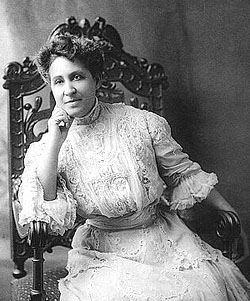
In World War I, Terrell was involved with the War Camp Community Service, which supported recreation for servicemen. Later it aided in issues related to the demobilization of Negro servicemen. As the war was winding down, Terrell and her daughter Phyllis joined Alice Paul and Lucy Burns, of the Congressional Union for Woman Suffrage (CUWS), to picket the White House on issues related to the need of black veterans for jobs. Terrell was a delegate to the International Peace Conference after the end of the war. While in England, she stayed with H. G. Wells and his wife at their invitation.
Terrell worked actively in the women’s suffrage movement, which pushed for the enactment of the Nineteenth Amendment to the United States Constitution. Active in the Republican Party, she was president of the Women’s Republican League during Warren G. Harding’s 1920 presidential campaign and the first election in which primarily American white women were given the right to vote. The Southern states from 1890 to 1908 passed voter registration and election laws that suppressed African-Americans’ right to vote. These restrictions were not fully overturned until after Congressional passage of the Voting Rights Act of 1965. Though Terrell died in 1954, her legacy and early fight for black women to vote continues to be cited.
Terrell wrote an autobiography, A Colored Woman in a White World (1940), which accounts for her personal experiences with racism.
In 1950, she started what would be a successful fight to integrate eating places in the District of Columbia. In the 1890s the District of Columbia had formalized segregation, as did states in the South. Before then, local integration laws dating to the 1870s had required all eating-place proprietors “to serve any respectable, well-behaved person regardless of color, or face a $1,000 fine and forfeiture of their license.” In 1949, Terrell and colleagues Clark F. King, Essie Thompson, and Arthur F. Elmer entered the segregated Thompson Restaurant. When refused service, they promptly filed a lawsuit. Attorney Ringgold Hart, representing Thompson, argued on April 1, 1950, that the District laws were unconstitutional, and later won the case against restaurant segregation. In the three years pending a decision in District of Columbia v. John R. Thompson Co., Terrell targeted other restaurants. Her tactics included boycotts, picketing, and sit-ins. Finally, on June 8, 1953, the court ruled that segregated eating places in Washington, DC, was unconstitutional.
After the age of 80, Terrell continued to participate in picket lines, protesting the segregation of restaurants and theaters. During her senior years, she also succeeded in persuading the local chapter of the American Association of University Women to admit black members.
She lived to see the Supreme Court’s decision in Brown v. Board of Education, holding unconstitutional the racial segregation of public schools. Terrell died two months later at the age of 90, on July 24, 1954, in Anne Arundel General Hospital in Highland Beach, Maryland. It was the week before the NACW was to hold its annual meeting in the town she lived in, Annapolis, Maryland.
